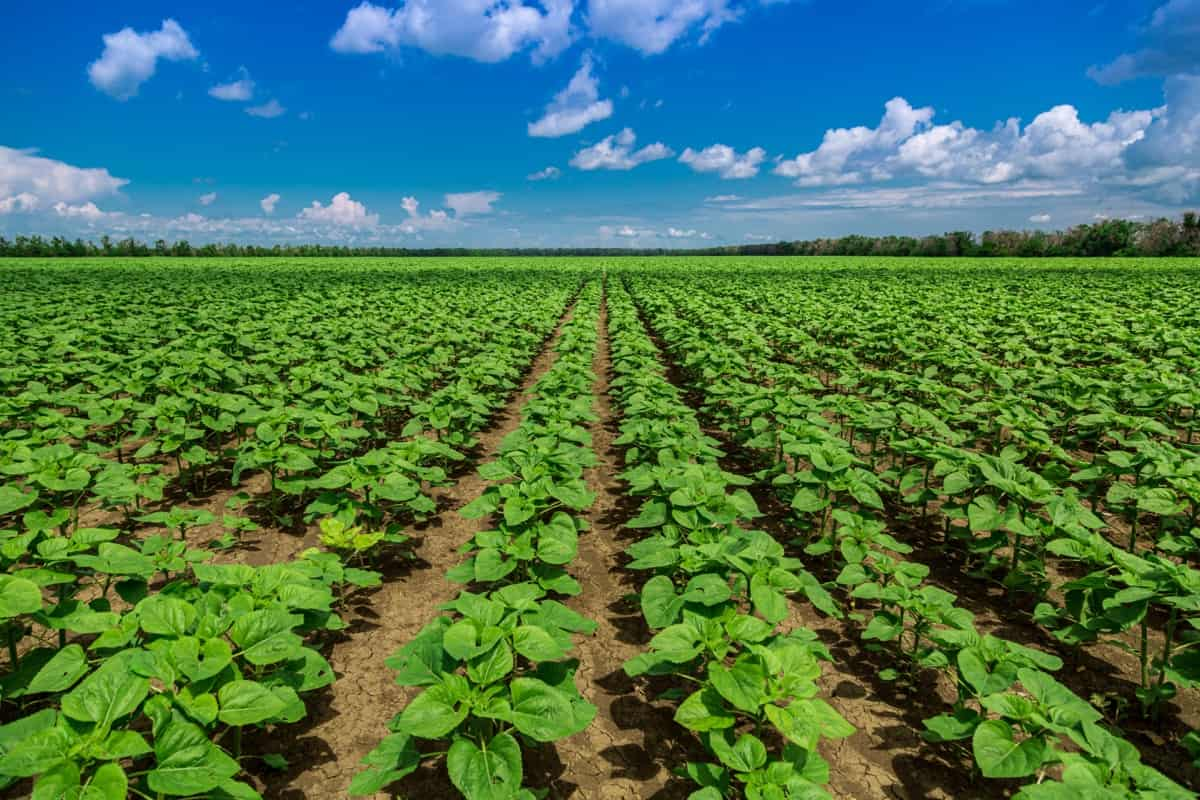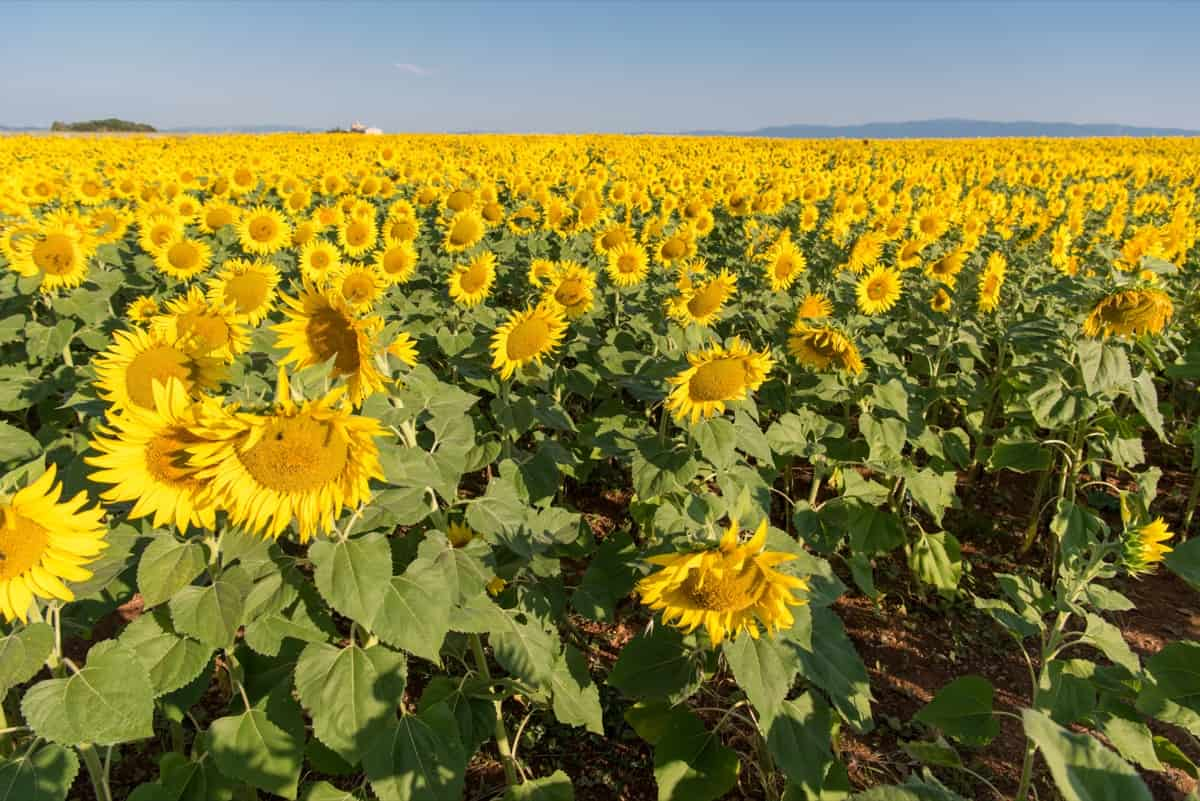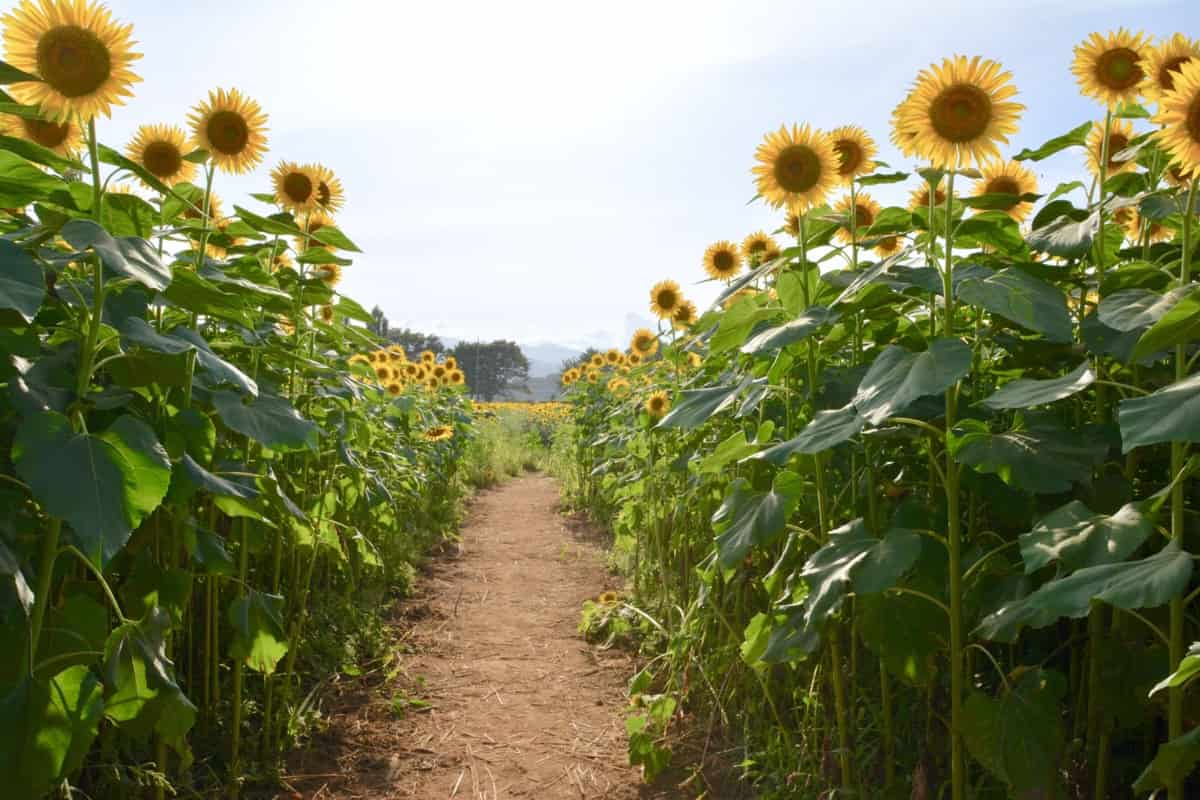Welcome to the world of gardening and sustainable landscape management! When cultivating a vibrant garden filled with sunflowers, tackling weed management is a key challenge. We understand the importance of maintaining those picturesque sunflower beds without letting pesky weeds steal the spotlight. This blog delves into effective and easy-to-implement strategies for managing weeds in your sunflower patch.

Introduction to Sunflower Weed Management
Sunflower cultivation is a vital oilseed crop in India, ranking third after soybean and groundnut for its edible oil contribution. The versatility of sunflower as a year-round crop with oil rich in polyunsaturated fatty acids (PUFA) is noteworthy. However, the menace of weeds poses a substantial threat, leading to potential seed yield losses ranging from 45% to 55%. A study by Wanjari et al. (2001) has highlighted this concern.
Effectively managing weeds in sunflower fields necessitates the integration of cultural, mechanical, and chemical control practices. The clay loam soil exhibited a pH of 7.8 and a nutrient content of 234.5 kg/ha of available nitrogen, 22.5 kg/ha of available phosphorus (P2O5), and 327.5 kg/ha of available potassium (K2O).
The predominant weed species observed were Echinochloa colona, Cyperus rotundus, Cleome viscosa, Trianthema portulacastrum, Eclipta alba, Phyllanthus niruri, and Phyllanthus madraspetensis. The results notably favored the efficacy of twice hand weeding with 15 and 30 days after sowing, closely followed by fluchloralin application combined with intercropping. Alachlor, though effective, demonstrated slightly lesser efficiency compared to fluchloralin.
In case you missed it: Pest and Disease Management in Sunflower: Causes, Symptoms, Chemical and Biological Control

Understanding the Importance of Weed Management in Sunflower Production
- Enhanced Sunflower Growth: Effective weed management ensures sunflowers receive nutrients, water, and sunlight for healthy growth.
- Increased Yield: Studies indicate that proper weed control can boost sunflower yield by up to 30%, preventing competition.
- Reduced Yield Losses: Uncontrolled weeds can cause yield losses of over 50%, highlighting the necessity of weed management.
- Pest and Disease Prevention: Weeds can harbor pests and diseases, which can spread to sunflowers, causing additional crop damage.
- Economic Returns: Investing in weed control techniques, like herbicide application and mechanical removal, can result in a substantial economic return of up to $5 for every $1 spent.
- Optimized Quality: Weed-free environments improve sunflower quality, enhancing their market value.
- Sustainable Farming: Proper weed management supports sustainable farming practices by reducing reliance on chemical interventions.
Common Weeds Found in Sunflower Fields
Common weeds found in sunflower fields include Amaranthus viridis, Celosia argentena, Chloris barbata, Corchorus olitorius, Cynodon dactylon, and Cyperus rotundus. Effective weed management is crucial for sunflower production. Recommended herbicides like Fluchloralin (2.0 l/ha) and Pendimethalin are applied before or after sowing, followed by irrigation.
Hand weeding on the 15th and 30th day after sowing is advised, with a final hand weeding 30-35 days after sowing. Weeds can dry for 2-3 days in irrigated fields before irrigation. Proper weed control optimizes sunflower growth, yield, and quality.
Cultural Practices for Effective Weed Control in Sunflower Fields
- Crop Rotation: Rotate sunflowers with non-host crops to disrupt weed cycles and reduce pressure. This technique confuses weed growth patterns and prevents them from thriving.
- Proper Spacing: Adequate spacing between sunflower plants minimizes shading and limits weed establishment. This discourages weed growth by reducing available light and resources.
- Timely Planting: Early planting gives sunflowers a competitive advantage over emerging weeds. This allows sunflowers to establish themselves before weeds become problematic.
- Mulching: Applying organic mulch around sunflower plants suppresses weed germination and growth, conserves soil moisture and promotes sunflower health.
- Stale Seedbed Technique: Prepare the soil a few weeks before planting, allowing weed seeds to germinate. Then, cultivate or shallowly till to eliminate the emerged weeds before sunflower planting.
- Proper Fertilization: Balanced fertilization ensures sunflowers receive essential nutrients, promoting vigorous growth that can outcompete weeds.
Pre-planting Weed Management Strategies for Sunflowers
- Herbicide Application: Applying pre-emergence herbicides like Fluchloralin or Pendimethalin before planting forms a barrier against weed growth. This reduces weed pressure during sunflower germination.
- Tillage: Employ shallow tillage to disturb weed seeds in the top soil layer. This hampers weed emergence and allows sunflowers to establish themselves without competition.
- Cover Crops: Planting crops like rye or clover before sunflower planting can suppress weed growth. These cover crops outcompete weeds for resources and provide a protective layer.
- Soil Solarization: This technique covers the planting area with transparent plastic to trap heat. This kills weed seeds and seedlings, reducing weed populations.
- Cultivation: Cultivating the soil a few weeks before planting disrupts weed growth and exposes weed seeds to unfavorable conditions.
Example: Before sunflower planting, apply Fluchloralin herbicide to the soil. This forms a barrier that inhibits weed growth during sunflower germination, promoting unimpeded sunflower growth.
In case you missed it: Best Fertilizer for Sunflower Crop: Organic, NPK, Compost Manure, and Schedule

Post-emergence Herbicide Options for Sunflower Weed Control
- Imazethapyr: This herbicide targets broadleaf weeds and grasses. It’s applied post-emergence and is highly effective against troublesome weeds like pigweed and foxtail.
- Bentazon: Known for its versatility, bentazon controls various broadleaf weeds. It’s particularly useful against smartweed and nightshade species.
- Nicosulfuron: Effective against the grass and broadleaf weeds, nicosulfuron is applied post-emergence and offers long-lasting control.
- Bromoxynil: This herbicide focuses on broadleaf weeds, including dandelion and lambsquarters. It works quickly and provides reliable results.
- Quizalofop-P-ethyl: Specifically designed for grass control, quizalofop-P-ethyl targets grassy weeds like barnyard grass and crabgrass.
- Clethodim: Effective against grasses, clethodim is ideal for combating grassy weeds without harming sunflowers.
Selective Herbicides for Targeted Weed Control in Sunflower Crops
Selective herbicides are essential for precise weed management in sunflower fields, ensuring robust growth and maximum yields. These include flumioxazin, bispyribac-sodium, pyrroxasulfone, S-metolachlor, fluroxypyr, and cyanazine. Flumioxazin targets broadleaf and grassy weeds, Bispyribac-sodium targets grasses, Pyroxasulfone targets broadleaf weeds, S-metolachlor targets grasses, Fluroxypyr targets broadleaf weeds, and Cyanazine safeguards sunflower growth.
Integrated Weed Management Approaches for Sustainable Sunflower Production
Cultivation Practices: Utilize pre- and post-emergence tillage, ensuring a weed-free start. The stale seedbed technique stimulates weed germination before shallow tilling. Post-emergence harrowing and hoeing further control weeds, but caution is advised to avoid crop damage.
Soil Solarization: Cover moist soil with clear sheets during hot periods, increasing soil temperature by around ten °C (50°F). Combined with tillage, this technique suppresses weed seeds in deeper soil layers, effectively reducing weed survival and germination.
Crop Rotation and Biological Control: Rotate sunflowers with non-host crops to break weed cycles. Beneficial Arbuscular Mycorrhiza fungi can hinder Orobanche seed germination. Biological diversity aids in weed control.
Herbicide-Resistant Varieties: Choose sunflower varieties resistant to specific herbicides like Clearfield® and ExpressSun®. These allow targeted herbicide application without harming crops, effectively controlling weeds.
Chemical Control with Caution: Use herbicides judiciously after consulting a licensed agronomist. Apply pre-sowing and post-emergence treatments, considering herbicide efficacy against various weed species. Avoid hormonal herbicides due to sunflower sensitivity.
Rotation of Herbicide Modes of Action: Prevent herbicide resistance by alternating modes of action. Avoid repeated use of the same herbicide class.
In case you missed it: Organic Sunflower Production – Cultivation, Farming

Mechanical Weed Control Techniques for Sunflower Fields
- Hand Weeding: Performing two hand weedings at 20 and 40 days after sowing (DAS) is essential. This manual removal of weeds reduces competition and helps sunflowers thrive.
- Intercultural Operations: Two intercultural operations between 20 and 45 DAS are recommended. These operations involve soil cultivation between rows, minimizing weed growth, and enhancing sunflower development.
- Earthing Up: Earthing up along rows is advised as sunflowers reach a knee-high stage. This practice prevents lodging caused by strong winds and curbs weed growth.
- Herbicide Application: To efficiently manage weeds, consider herbicide application. Butachlor 50 EC at 3.0 liters/ha, Pendimethalin 30 EC at 4.5 liters/ha, or Fluchloralin 45 EC at 3.0 liters/ha can be sprayed in 1000 liters of water on the day of sowing or the following day. Adequate soil moisture and a clod-free field are prerequisites for effective application. Be cautious to avoid trampling after spraying.
Biological Control Methods for Managing Weeds in Sunflowers
Biological control involves utilizing natural enemies like insects, pathogens, or organisms to manage weeds in sunflower fields. Beneficial insects, such as certain beetles and weevils, feed on weed species, reducing their growth. Similarly, plant pathogens or fungi specifically target and suppress weeds. Integrating these biological methods can provide sustainable and eco-friendly weed management, minimizing reliance on chemical interventions and promoting healthier sunflower crops.
Crop Rotation and Cover Crops for Suppressing Weeds in Sunflower Fields
Crop rotation and cover crops are effective strategies for weed suppression in sunflower fields. Monoculture can lead to weed proliferation. Rotating sunflowers with crops like peas, barley, wheat, soybeans, or corn disrupts weed cycles. Alternating with grass crops, such as corn or wheat, allows targeted herbicide use against grass and broadleaf weeds in consecutive years.
Caution is needed with herbicides having extended residuals that might harm subsequent crops. Arbuscular Mycorrhiza presence aids weed control by reducing Orobanche seed germination. These soil fungi create symbiotic relationships with plant roots, offering numerous benefits.
Importance of Timely Weed Monitoring and Scouting in Sunflower Production
Timely weed monitoring and scouting are critical in sunflower production. Regular observation allows early weed growth and competition detection, enabling swift intervention. Identifying and addressing weed issues promptly prevent them from hindering sunflower growth and development.
Effective management strategies, such as timely herbicide applications or cultural practices, can be implemented in response to the specific weed species and their growth stages. Farmers can ensure healthier sunflower crops, higher yields, and sustainable production by staying vigilant and taking proactive measures.
In case you missed it: Sunflower Seed Germination, Time, Temperature, Process

Herbicide Resistance Management in Sunflower Weed Control
Herbicide resistance management is essential in sunflower weed control. Overreliance on a single herbicide can lead to resistant weed populations, reducing effectiveness. To counter this, farmers should adopt diverse weed management strategies. Rotate herbicides with different modes and control of action, preventing weed adaptation.
Integrate cultural practices like crop rotation, cover cropping, and tillage to minimize herbicide dependence. Employ targeted application methods, optimizing herbicide efficacy while minimizing environmental impact. Regularly monitor and scout for resistant weeds, adjusting management approaches as needed. Collaborate with agronomists to design customized herbicide programs and implement sustainable practices.
Best Practices for Herbicide Application in Sunflower Fields
- Calibration: Ensure accurate equipment calibration for proper dosage.
- Timing: Apply herbicides during the right growth stage of weeds for maximum effectiveness.
- Weather Conditions: Choose calm, non-windy days to prevent drift.
- Spray Drift Management: Use appropriate nozzles and pressure to minimize drift.
- Spray Coverage: Achieve thorough coverage of target weeds.
- Mixing Order: Follow the recommended order while mixing herbicides.
- Adjuvants: Use adjuvants as directed to enhance herbicide efficacy.
- Clean Equipment: Thoroughly clean sprayers before and after use to prevent contamination.
Integrated Weed Management for Sunflower Fields
- Understanding Weed Dynamics: Identify weed species, population size, and distribution across the field. Crop rotation influences weed species, guiding targeted management efforts.
- Learning from Past Strategies: Evaluate previously used weed control techniques and herbicides. Diversify methods to prevent herbicide resistance and promote efficient weed suppression.
- Critical Period Identification: Determine when sunflower seedlings are most vulnerable to weed competition. This phase typically lasts 6-9.5 weeks after germination.
- Major Weed Species: Recognize key weed species affecting sunflowers, including grasses, broadleaf varieties, and obligate parasites like broomrape. Adapt strategies based on prevalent weeds.
- Broomrape Challenge: Acknowledge the emergence of broomrape as a significant problem in sunflower production, particularly in Europe and Asia. Broomrape is a root parasite, necessitating specialized control measures.
- Cultivation Practices: Utilize pre- and post-emergence tillage techniques. Stale seedbed preparation, harrowing, and cultivation at optimal growth stages deter weed growth.
- Soil Solarization: Implement passive solar heating using clear polyethylene sheets on moist soil for elevated temperatures. When combined with tillage, solarization curbs weed seed germination.
- Crop Rotation and Cover Crops: Rotate sunflowers with other crops like peas, barley, and soybeans to break weed cycles. Grass crops like corn and wheat allow targeted herbicide use. Avoid using herbicides with prolonged residuals.
- Biological Control and Mycorrhiza: Harness the benefits of Arbuscular Mycorrhiza fungi to curb weed germination. These symbiotic fungi foster plant growth and suppress weed development.
- Variety Selection: Opt for herbicide-resistant sunflower varieties, such as Clearfield® and ExpressSun®, to mitigate specific weed challenges. These non-GMO varieties resist certain herbicides.
- Chemical Control with Caution: Employ herbicides judiciously after consulting agronomists. Select active compounds based on weed species and growth stage. Avoid hormonal herbicides that could harm sunflowers.
- Herbicide Mode Rotation: Alternate herbicide modes of action to prevent weed resistance. Diverse modes reduce the likelihood of weeds adapting and surviving.
In case you missed it: Different Types of Growing Mediums for DWC: Deep Water Culture Hydroponics

Conclusion
Effective sunflower weed management is essential for optimal crop growth and yield. Integrated approaches are key, including cultural practices, rotation, herbicide application, and biological control. Monitoring, early intervention, and sustainable strategies ensure successful sunflower cultivation while minimizing weed-related challenges.
- Modern Sheep Farming Technology: The Future of Sheep Husbandry
- Goat Farming Technology: The Future of Goat Husbandry
- How to Build a Low-budget Goat Shed: Cheap Ideas and Tips
- Goat Farming Training Programs in India: A Beginner’s Guide
- Types of Pesticides Used in Agriculture: A Beginner’s Guide
- Economical Aquaculture: A Guide to Low-Budget Fish Farming
- 15 Common Planting Errors That Can Doom Your Fruit Trees
- How to Make Houseplants Bushy: Effective Tips and Ideas
- Innovative Strategies for Boosting Coconut Pollination and Yield
- Pollination Strategies for Maximum Pumpkin Yield
- The Complete Guide to Chicken Fattening: Strategies for Maximum Growth
- Natural Solutions for Tulip Problems: 100% Effective Remedies for Leaf and Bulb-Related Issues
- Revolutionizing Citrus Preservation: Towards a Healthier, Greener Future
- Natural Solutions for Peony Leaf and Flower Problems: 100% Effective Remedies
- Maximizing Profits with Avocado Contract Farming in India: A Comprehensive Guide
- Natural Solutions for Hydrangea Problems: 100% Effective Remedies for Leaf and Flowers
- The Ultimate Guide to Choosing the Perfect Foliage Friend: Bringing Life Indoors
- From Sunlight to Sustainability: 15 Ways to Use Solar Technology in Agriculture
- The Ultimate Guide to Dong Tao Chicken: Exploring from History to Raising
- The Eco-Friendly Makeover: How to Convert Your Unused Swimming Pool into a Fish Pond
- Mastering the Art of Delaware Chicken Farming: Essentials for Healthy Backyard Flocks
- 20 Best Homemade Fertilizers for Money Plant: DIY Recipes and Application Methods
- How to Craft a Comprehensive Free-Range Chicken Farming Business Plan
- Brighten Your Flock: Raising Easter Egger Chickens for Beauty and Bounty
- How to Optimize Your Poultry Egg Farm Business Plan with These Strategies
- Subsidy for Spirulina Cultivation: How Indian Government Schemes Encouraging Spirulina Farmers
- Ultimate Guide to Raising Dominique Chickens: Breeding, Feeding, Egg-Production, and Care
- Mastering the Art of Raising Jersey Giant Chickens: Care, Feeding, and More
- Ultimate Guide to Raising Legbar Chickens: Breeding, Farming Practices, Diet, Egg-Production
- How to Raise Welsummer Chickens: A Comprehensive Guide for Beginners
- How to Protect Indoor Plants in Winter: A Comprehensive Guide
- Ultimate Guide to Grow Bag Gardening: Tips, Tricks, and Planting Ideas for Urban Gardeners
- Guide to Lotus Cultivation: How to Propagate, Plant, Grow, Care, Cost, and Profit
- Agriculture Drone Subsidy Scheme: Government Kisan Subsidy, License, and How to Apply Online
- Ultimate Guide to Raising Araucana Chickens: Breed Profile, Farming Economics, Diet, and Care
- Bringing Hydroponics to Classroom: Importance, Benefits of Learning for School Students